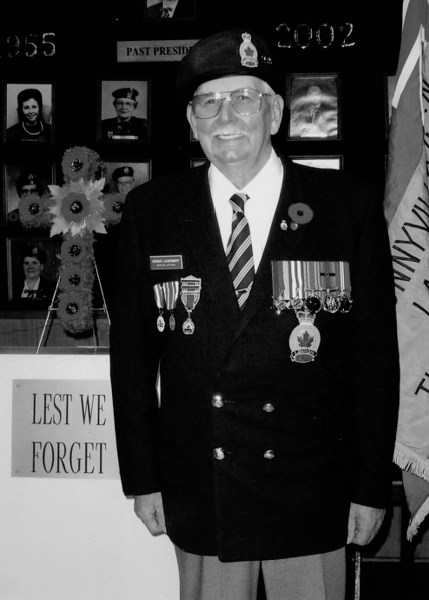The significance of Remembrance Day is different for everyone; for one local veteran the day is a time to remember his friends and family who spent time fighting in the war.
“When I think of Remembrance Day, the first person I think of is my grandfather,” said George Laquement, a 90-year-old World War II veteran who currently resides in Bonnyville.
“I have all of his medals and his citation. I have them mounted in a little box. He is the first person I think of because he had been wounded. He had shrapnel all over (his hand and arm) and you could move it around.”
Laquement's grandfather was an officer in the French Army during World War I, while Laquement himself served as a member of the top-secret Kangaroos during World War II.
“The next thing I think of are all of the people that stayed over there, the ones that never came back,” added Laquement. “It is nice to remember and give thanks that we are able to enjoy life like we do.”
In 1932 Laquement's family moved from southern Alberta up to Ardmore. Years later he found himself in the army, situated as a member of the Canadian 25th Armoured Delivery Regiment – The Elgin's – based out of St. Thomas, Ontario. He bounced around Ontario in the early 1940's working as a driver and mechanic, fixing and test-driving tanks and all sorts of armoured vehicles.
In the summer of 1944 two squadrons from The Elgin's were used to create the 1st Canadian Armoured Carrier Regiment or the Kangaroos, as they were better known.
Troops in the regiment, which included Laquement, went to Holland where they modified tanks into armoured infantry carriers. American M7 Priest's were gutted, had their guns removed, were fitted with extra armour, and turned into infantry carriers.
Members of the regiment were soon called Kangaroos because the newly configured tank acted as an armoured pouch that could safely carry infantry and supplies to the front lines.
“I can remember when we entered Germany,” said Laqeument. “We were the first ones that entered Germany from Nijmegen, Holland.”
The Kangaroos would drive their tanks, which carried three to five members, across the border into Germany where they would pop out, machine guns in hand, and surprise the German infantry. Laquement, being a “head man,” rode in a tank with only one other passenger.
“We went through Kleve,” said Laquement. “I have a buddy in Edmonton who was in the air force with the bombers. They bombed that town before we got there and when we got there things were pretty well smashed up and we finished it.”
Laquement remembers wandering through the remains of the small German town dodging large shells being shot at them from the coast.
“The Germans had big guns on the coast and they turned those coastal gun around and were shelling us,” said Laquement.
“Those guns were big, about a 24-inch bore and about six feet long. I didn't see any (shells) hit any targets but I saw them hit the ground. That scared the hell out of us.”
Germany, according to Laquement, was a lot of countryside with big tall trees lining the road and driveways. The scene wasn't as picturesque when he was over there as the Germans were using the trees to their advantage.
“They were shooting mortars into the trees and they were exploding at the tops of the trees. That was really interesting, I'll tell you.”
Although he struggles to remember most of what he experienced during the war, Laquement does remember where he was when World War II officially ended on Sept. 2, 1945.
“I was in a convalescent hospital,” Laquement said. “They changed it over and made it a rehabilitation centre (after the war ended). They put me in charge of transport and the workshops they had. They let me teach a class of mechanics.
It wasn't until February of 1946 that Laquement finally made it back to Canada.
“It was a big change,” Laquement said, referring to his return home.
Every year Laquement attends the local Remembrance Day Ceremonies in Bonnyville. Last year, in 2013, he missed his first ceremony in a long time due to health issues.
While he has been going to Remembrance Day ceremonies and recognizing those who fought in the war for years, it wasn't until just recently that he and his fellow Kangaroos received the long-awaited recognition that they deserve.
The Kangaroos created a method of transporting troops into battle, which benefited many during World War II and pioneered a transportation method that is still used today.
“We saved lives with this,” said Laqeument. “We kept our allies safe. We brought men in. We evacuated personnel. We evacuated civilians in danger. Our regiment had a lot of success.”
The Kangaroos aren't well known for their success as they were a top-secret group which holds the distinction of being the only Canadian regiment never to set foot in Canada, having been formed in Holland in August of 1944 and disbanded when the war ended in September of 1945.
It wasn't until 2010 – 66 years after their creation – that the Kangaroos were officially recognized and thanked for their involvement in the war.
According to Laquement, the Kangaroos were also recently recognized by the Queen and issued the Royal Insignia, which he feels, “is a big thing.”
This past Saturday, Nov.8, the Kangaroos held a reunion in Toronto, which saw many of the children of former Kangaroos come out and reminisce about their parents accomplishment. As for the veterans, of the 550 men who represented the secret regiment in war only five to seven remain. One of those remaining members, Laquement, is right here in Bonnyville.



